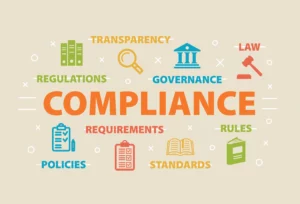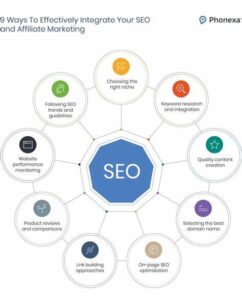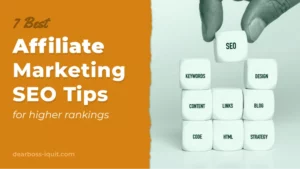In affiliate marketing, understanding SEO is like knowing the rules of a game you’re trying to win. It’s essential to know how search engines work to get your content seen by potential customers. SEO, or search engine optimization, helps improve the visibility of your online content by aligning it with what search engines prioritize.

For affiliate marketers, SEO isn’t just a tool to attract clicks; it’s the bridge that connects products or services with the right audience. By optimizing for search engines, you’re ensuring that your content appears in relevant search results, which is key to driving organic traffic and making affiliate sales.
click here to start your own online business for free Ced0224
There’s a strong bond between SEO and affiliate marketing. Getting familiar with SEO tactics can dramatically boost your marketing efforts, helping you stand out in a crowded digital marketplace. The focus should always be on producing people-first content, which means prioritizing the needs and experiences of readers over merely trying to appease search engine algorithms.
High-quality and relevant content is what ultimately engages and retains an audience. When crafting your content, consider what users genuinely want to read and learn from it. As algorithms evolve, search engines are becoming smarter and emphasize content that genuinely assists users rather than pages overloaded with keywords without real substance.
Common SEO Mistakes Affiliates Make and How to Avoid Them
SEO can be tricky, and it’s no surprise that even seasoned affiliate marketers slip up now and then. One of the main blunders is keyword stuffing. This involves cramming as many keywords into your content as possible, which used to be a go-to method back in the day. But times have changed. Search engines now prioritize relevance and readability over excessive keyword use. By naturally integrating keywords, your content not only avoids penalties but also reads better for your audience.
Another pitfall is forgetting about the user’s search intent. It’s crucial to understand the type of information your audience is looking for. If someone searches for ‘best running shoes’, they probably want to see a comparison or a list of top picks, not a single product review. Aligning your content with user intent boosts engagement and relevance, increasing chances for better rankings.
Balancing on-page and off-page SEO strategies is another area where affiliates often falter. On-page SEO, like content structure and internal linking, works hand-in-hand with off-page SEO strategies, such as backlinks and social media signals. Neglecting one for the other can weaken your overall SEO efforts. Maintaining a balance ensures a comprehensive approach that maximizes visibility and traffic.

By avoiding these mistakes, you improve the trustworthiness and authority of your site. This not only benefits your SEO but also establishes a reputation with your audience, leading to higher affiliate sales in the long run.
Effective Use of Keywords for Better Search Ranking
Keywords are the backbone of any strong SEO strategy, but using them effectively can make all the difference. It’s crucial to move beyond just finding the right keywords and focus on seamlessly weaving them into your content. This improves your visibility without sacrificing the quality of what you write.
Incorporating LSI (Latent Semantic Indexing) keywords is a smart approach to create content that resonates with search queries naturally. LSI keywords are words and phrases closely related to your main keyword. By using them, you provide context to search engines, helping them understand the nuances of your content. This makes your site more likely to rank for a variety of related search queries.
Long-tail keywords present yet another opportunity. Though they have a lower search volume, they often carry higher intent and less competition. For affiliate marketers, capitalizing on these can mean reaching a more dedicated audience. For example, instead of targeting a generic term like ‘phones’, using ‘best smartphones for photography’ can attract users looking for specific advice.
Integrating keywords naturally into your content is important. Gone are the days when mechanical placement sufficed. Aim to keep your content readable and enjoyable, where keywords fit seamlessly into the narrative. This approach not only satisfies search engines but also enhances user experience, making visitors more likely to engage with your content and take action.

Remember, keywords should guide your content creation, not dictate it. Each piece you write should address real questions or needs of your audience, with keywords serving to help these users find your valuable insights.
Enhancing User Experience to Improve SEO Performance
User experience is a critical component of SEO that often goes overlooked in the rush to climb search rankings. A well-optimized website not only appeals to search engines but also makes visitors want to stick around. Keeping users engaged is key, and it starts with site speed.
A fast-loading site is crucial. If your pages take too long to load, potential customers might leave before they even see your awesome content. Tools like Google’s PageSpeed Insights can offer practical tips on speeding up your site. Reducing image sizes, implementing caching, and cleaning up unnecessary scripts can all help.
Mobile optimization is another vital piece of the puzzle. With an increasing number of users accessing content on their phones, ensuring your site is responsive and easy to navigate on smaller screens can significantly influence your rankings and user satisfaction.
Crafting compelling meta descriptions and titles is also essential. These are the first things users see on search engine results pages, so make them count. A gripping title and an informative meta description encourage clicks. Think of them as a sneak peek of what users can expect when they visit your page.
Focusing on these elements not only keeps users on your site longer but also sends positive signals to search engines about the quality and relevance of your site. Great user experience naturally complements good SEO practices, making it a win-win situation for both you and your audience.
Monitoring and Adapting Your SEO Strategy Over Time
Keeping tabs on your SEO efforts is an ongoing task. Just like a well-tended garden, your strategy needs attention, tweaking, and sometimes a complete overhaul. Analytics tools are your best friend here. Platforms like Google Analytics offer insights into what’s working and where you might need to shift focus.
Understanding analytics data can help you identify which keywords are driving traffic and which pages are performing best. With this info, you can adapt your content strategy to capitalize on what’s successful, while cutting back on less effective approaches.
Search engine algorithms are constantly evolving, meaning your strategy needs to be flexible. Staying updated with changes can be daunting, but it’s vital. Following industry blogs, subscribing to newsletters, or joining relevant forums ensures you’re never out of the loop.
A/B testing is another powerful tool in your arsenal. By testing different elements like headings, layouts, or CTAs, you can gain valuable insights into what really resonates with your audience. This continual learning process not only fine-tunes your SEO strategy but also enhances your content’s impact.

Adapting to change and learning from your results is what keeps your SEO strategy effective over time. This proactive approach not only improves your search performance but also keeps your content fresh and engaging for your audience.
